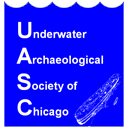The Steam Barge Solon H. Johnson was built in 1875. She was originally 81' long, but was rebuilt in 1876 to be 106.5' long. Her engine was a single piston, high pressure, non-condensing steam engine with a 5'x8' tubular boiler. Steam barges were relatively small bulk freighters that had powerful engines and were designed to pull multiple barges while carrying a small cargo of it's own. Through her career, the Solon H. Johnson was primarily employed in the stone and lumber trades. She had at least eight different owners, many of which were extremely interesting and very well known, such as Charles Mears of Chicago, Thomas Pringle of Marine City, and James Johnson of Clayton, NY.
On the night of November 24, 1887, the Solon H. Johnson was heading from Pentwater, MI to Chicago with a load of lumber and towing a scow loaded with white Pentwater bricks. During a strong storm, her machinery broke and was driven ashore 8 miles south of Kenosha. A local farmer spotted the wreck and notified the Kenosha Life Saving Service who took their gear by train to the site of the wreck. They made a heroic effort to reach the Johnson with their life boat, but the high waves and wind forced them to turn back. However, they were able to fire a line to the wreck with their Lyle gun and used a breeches buoy to save all twelve men from the steam barge. Meanwhile, the LSS crew successfully used their lifeboat to reach the scow and rescued it's two man crew. The scow was later refloated by throwing the load of bricks into the lake, but the Johnson was unable to be refloated and became a total loss. Interestingly, 10 years later, a tug pulling a barge with the salvaged boiler from the Johnson went down off Grosse Point and was also a total loss.
The wrecksite has long been known to local divers but was just identified in 2011 as the Solon H. Johnson. Severe storms over the last two years have broken the wreck into two pieces and in December 2012, the bow section washed ashore near the Zion nuclear power plant. These storms have washed away most of the loose artifacts that were still in place in 2011, but some of the cargo of wood lathe and the steam engine are still in place.
